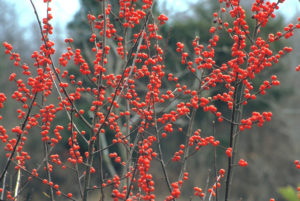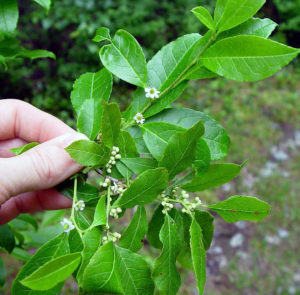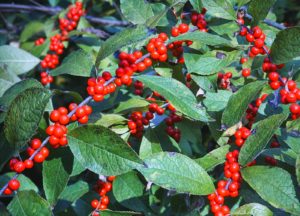Common Name: Common Winterberry
Specific Name: Ilex verticillata
Known Occurrence at Taylor Point:
Map areas: Cliffs 2A, Cliffs 2H,
Woodlands 3A, Woodlands 3B
Category: Native, Shrub

Ecological Considerations:
Ilex verticillata is an erect moderate sized shrub, growing to heights of 5 to 15 feet tall. The smooth bark of winterberry is gray to blackish, with knobby lenticels. The dense branches of this shrub grow in a zigzag pattern with an upright spreading crown. The twigs are slender, with gray to gray-brown color and small buds.
The simple, smooth, obovate to oblong-ovate foliage is sharply double toothed, with medium fine texture. The deciduous leaves are arranged alternately along the stems. Each leaf is 1 1/2 to 4 inches long, with dark green summer color turning yellow in fall, then drop off by mid-October.
Small, inconspicuous, axillary, greenish to yellowish- white flowers bloom from April to July, after leaves have emerged. Like most others in the holly genus, winterberry is dioecious(separate male and female plants).
Three years after planting, pistillate flowers begin to emerge in small clusters plants and staminate flowers develop on male plants with up to twelve flowers in a cluster; only now can plant gender be determined. Scarlet red to orange, globular fruit mature by late summer, often remaining on the plant into mid-winter. The berry- like fruit is about 1/4 inch in diameter, occurring singlely or in pairs, each containing 3 to 5 small nutlets. There are an average of 92,000 seeds per pound. (Contributed by: USDA NRCS Plant Materials Program)
Invasive plants at Taylor Point that may possibly be replaced successfully by this plant:
Map areas where this plant can be used for revegetation:
Black cherry woodland – 3A
Black cherry woodland – 3B
Black cherry woodland – 3C
Propagation Mechanisms/Strategies for Encouraging its Establishment:
Easily grown in average, acidic, medium to wet soils in full sun to part shade. Adaptable to both light and heavy soils, but prefers moist, acidic, organic loams. Good tolerance for poorly drained soils including wet boggy or swampy conditions (this species is native to swampy areas of Eastern North America). Only fertilized female flowers will produce the attractive red berries that are the signature of the species. Generally one male winterberry will be sufficient for pollinating 6-10 female plants. Flowers appear on new growth.
Best Planting Practices/Options and Pros and Cons of Options:
It is important to plant both male and females within 40 feet of one another for adequate pollination.
Key Issues Regarding its Ecology (e.g. Which Invasives Threaten it, What Conditions Favor it):
Associated Ecological Benefits:
The attractive bright red fruit of winterberry is eaten by small mammals and more than 48 species of birds. For wildlife plantings, it is advantageous to plant higher numbers of females.
Availability of Locally Sourced Seeds and Plants:
Evergreen Tree & Landscape
The Farmer’s Daughter
Airport Nursery info
Wildwood Nurseries info
Stewart Nursery
Case Studies of Native Plant Establishment Efforts/Lessons Learned:
Additional photos:


Sources cited:
Search at Rhode Island Native Plant Guide
USDA Fact Sheet
Missouri Botanical Garden
Key Words:
native
shrub
Ilex verticillata
Common Winterberry
